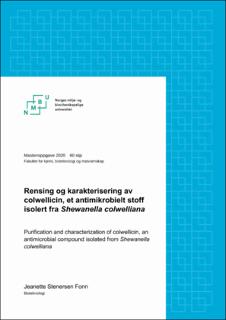| dc.contributor.advisor | Håvarstein, Leiv Sigve | |
| dc.contributor.advisor | Straume, Daniel | |
| dc.contributor.author | Fonn, Jeanette Stenersen | |
| dc.date.accessioned | 2020-10-16T13:43:21Z | |
| dc.date.available | 2020-10-16T13:43:21Z | |
| dc.date.issued | 2020 | |
| dc.identifier.uri | https://hdl.handle.net/11250/2683415 | |
| dc.description.abstract | Da antibiotika ble introdusert på markedet, gav det håp om at infeksiøse sykdommer kunne bli bekjempet en gang for alle. Denne optimismen ble etter hvert overskygget av et økende antibiotikaresistensproblem. Resistensproblemet skyldes i stor grad et stort og ukritisk forbruk av antibiotika, noe som har skapt et selektivt press for resistensutvikling. For å bekjempe resistensproblemet er det viktig å begrense antibiotikaforbruket og å hindre smittespredning. I tillegg er det viktig å utvikle nye antibiotika. En mulig kilde til nye antibiotika kan være marine bakterier. Bakterier som vokser på overflater i marine miljøer har stor biodiversitet og leveforholdene er preget av sterk konkurranse, noe som fører til produksjon av et bredt spektrum av sekundærmetabolitter. Noen av disse kan ha antimikrobiell aktivitet og følgelig være kandidater for nye og effektive antibiotika. I denne oppgaven ble derfor marine bakterier undersøkt som en mulig kilde til nye antibiotika.
Bakterier ble isolert fra prøver tatt i Oslofjorden, og undersøkt for antimikrobiell aktivitet mot det opportunistiske patogenet S. pneumoniae. Ett isolat med lovende antimikrobiell aktivitet ble identifisert som Shewanella colwelliana ved hjelp av 16S rRNA sekvensering. S. colwelliana produser et antimikrobielt stoff som ble kalt colwellicin.
Colwellicin ble forsøkt renset til homogenitet med flere ulike metoder, men dette viste seg å være en svært vanskelig oppgave. Det ble derfor utviklet en protokoll for anrikning og delvis rensing av colwellicin. I første trinn av protokollen ble colwellicin adsorbert til Amberlite XAD1180N og deretter eluert med 100% metanol. I neste rensetrinn ble det foretatt en butanolekstraksjon, og til sist ble det benyttet en Oasis kolonne koblet til ÄKTAprime plus kromatografiinstrumentet.
Colwellicin har antimikrobiell aktivitet mot 15 ulike streptokokkarter, og mot Bacillus subtilis, Enterococcus faecalis, Lactococcus lactis og Staphylococcus aureus. Det virker derfor som at colwellicin har bredspektret aktivitet mot Gram-positive bakterier. Dessverre har colwellicin også hemolytisk aktivitet, noe som begrenser bruken av stoffet ved behandling av infeksjoner.
Den eksakte virkningsmekanismen til colwellicin ble ikke klarlagt, men forsøk med sytox green og levende/død farging av S. pneumoniae RH14 behandlet med colwellicin tyder på at colwellicin angriper cellemembranen. Dette kan skje ved at colwellicin ødelegger integriteten til selve cellemembranen eller angriper essensielle prosesser som foregår i cellemembranen. Karakteriseringen av colwellicin tyder også på at det antimikrobielle stoffet har surfaktantlignende egenskaper og at colwellicin sannsynligvis danner miceller. | en_US |
| dc.description.abstract | Many believed that infectious diseases would be conquered after the introduction of antibiotics to the market. However, the optimism was dampened when antibiotic resistance became an increasing problem. The antibiotic resistance problem is largely caused by an excessive and uncritical use of antibiotics, which has led to a gradual selection of bacteria with increasing resistance against antibiotics. To fight antibiotic resistance, it is necessary to restrict the use of antibiotics and to minimize the spread of infections. In addition, it is necessary to develop novel antibiotics. Marine bacteria are diverse and are often in fierce competition with each other when growing for instance in biofilms. This has led to the production of a wide range of secondary metabolites, some of which might have antimicrobial activity. Consequently, this work focuses on marine bacteria as a possible source of novel and effective antibiotics.
Bacteria isolated from the Oslo fjord were screened for antimicrobial activity against the opportunistic pathogen S. pneumoniae. One of the isolates displayed promising antimicrobial activity against the target bacterium. Using 16S rRNA sequencing this bacterium was identified as Shewanella colwelliana. S. colwelliana produces an antimicrobial compound that was named colwellicin.
Several different methods were used in an attempt to purify colwellicin to homogeneity. This proved to be a very difficult task, but eventually a partial purification protocol was developed. The protocol begins with enrichment of colwellicin using Amberlite XAD1180N followed by concentration and purification using butanol extraction. As a last step, colwellicin is further purified with an Oasis column connected to an ÄKTAprime plus chromatography system.
Colwellicin has antimicrobial activity against 15 different streptococcal species and against Bacillus subtilis, Enterococcus faecalis, Lactococcus lactis and Staphylococcus aureus. Hence, colwellicin displays a broad spectrum of antimicrobial activity, and might be active against most Gram-positive bacteria. Unfortunately, colwellicin also has hemolytic activity, which limits the use of colwellicin in the treatment of internal infections.
During the current thesis work it was not possible to elucidate the exact mechanism of action of colwellicin, but sytox green and live/dead staining of S. pneumonia RH14 treated with the antimicrobial showed that the cell membrane had been disrupted. This suggests that colwellicin attacks the integrity of the cell membrane to make it leaky or interferes with an essential physiological process taking place in the cell membrane. Furthermore, the characterization of colwellicin suggests that it functions as a surfactant and probably forms micelles. | en_US |
| dc.language.iso | nob | en_US |
| dc.publisher | Norwegian University of Life Sciences, Ås | en_US |
| dc.rights | Attribution-NonCommercial-NoDerivatives 4.0 Internasjonal | * |
| dc.rights.uri | http://creativecommons.org/licenses/by-nc-nd/4.0/deed.no | * |
| dc.subject | Antbiotika | en_US |
| dc.subject | Antbiotikaresistens | en_US |
| dc.subject | Colwellicin | en_US |
| dc.subject | Antibiotics | en_US |
| dc.subject | Antibiotic resistance | en_US |
| dc.title | Rensing og karakterisering av colwellicin, et antimikrobielt stoff isolert fra Shewanella colwelliana | en_US |
| dc.title.alternative | Purification and characterization of colwellicin, an antimicrobial compound isolated from Shewanella colwelliana | en_US |
| dc.type | Master thesis | en_US |
| dc.subject.nsi | VDP::Teknologi: 500::Bioteknologi: 590 | en_US |
| dc.source.pagenumber | 135 | en_US |
| dc.description.localcode | M-BIOTEK | en_US |

